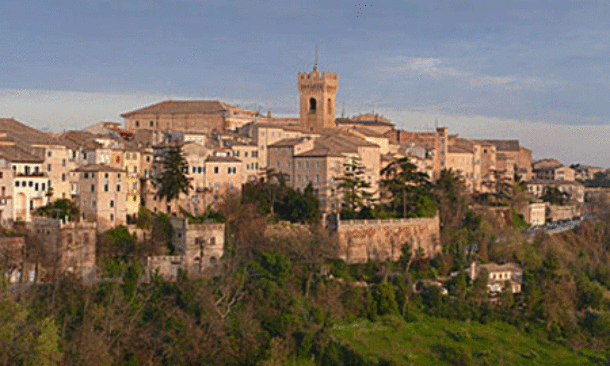
June 15th ushered in a new decree in Italy, allowing Italians to travel somewhat freely around the county. After three months of one of the strictest lockdowns in Europe, a change of scenery was most welcome. I still try to avoid large groups of people, though. Ferries, trains, and commercial airlines are not very appealing, even though the majority of Italians have been very courteous, wearing masks and respecting social distancing rules. I have never been more proud to be an Italian citizen than during this crisis. Though there are always exceptions to every generality, in Italy Covid-19 tended to unite people rather than divide them.

My first outing was a road trip to a part of Italy I did not know well—The Marche. I have landed at the small airport in Ancona, but that is not the same thing as traveling through a place. On the way to the Portonovo on the Riviera del Conero, I stopped in Ascoli Piceno, a lovely medieval city dotted with bell towers and wrapped in a warm golden light that seems to emanate from the travertine stone. The town is surrounded on three sides by the Tronto and Castellano rivers, so there are a number of elegant medieval bridges to stroll on after dinner. There are also two ancient Roman bridges, the Ponte di Cecco and the Solestà Bridge, dating from Augustus’s reign. The Solestà is a beautiful single arch bridge that was built to last. It is still in use, transporting goods and people over the Tronto just as the Romans designed it, as is the beautiful double-arched Porta Gemina built in the first century BC and through which the salt road enters the city.

There have been humans on this spot for a very long time, but its documented historical beginnings date back to a few centuries before Rome’s founding (that is, before 753 BC). It was on the ancient “salt road,” or via Salaria, connecting Latium with important salt producing regions on the Adriatic coast. As early as 268 BC it was considered a federated city and allowed to have a certain independence from Rome. However, as Rome’s power became more oppressive, Ascoli and a couple other central Italian cities rebelled against Rome in 91 BC. It was re-conquered and destroyed in 89 BC in the Battle of Asculum. Its remaining inhabitants were later granted Roman citizenship.
Because of its strategic importance, it was always fought over during the Middle Ages. Ravaged by Ostrogoths, Lombards, Franks, and eventually the Sforza, it was probably somewhat of relief when it fell under Papal authority until it was annexed by the Kingdom of Italy in 1860.
The town is a jewel. Its numerous bell towers, bridges, and arcaded passages lend the city a Renaissance grace that was even more pronounced because of the absence of tourists. Not that Ascoli Piceno is a huge tourist attraction anyway, but the post-Covid tranquility of this out-of-the-way region of Italy brought to mind what traveling must have been like a century ago. The perfectly proportioned Piazza del Popolo-- one of “the most beautiful” piazzas in Italy (many towns in Italy make that claim, and somehow it is always true)—is home to the Caffè Meletti, which I can confirm is indeed one of the most beautiful cafes in Italy.
Built in 1907, it is belle époque confection with high ceilings, warm wood, and curvilinear glass fixtures. It would be at home in Venice or Milan, and indeed famous patrons included the usual cast of cafe-loving characters like Ernest Hemingway, Jean-Paul Sartre, and Simone de Beauvoir. In Ascoli Piceno, it is just part of town life, serving caffè corretto, espresso with a healthy pour of its original recipe anisette, or an anisette inspired aperitivo with the local olive ascolane, enormous green olives stuffed with savory meat and fried.

On the way to the beach town of Portonovo and the Fortino Napoleanico, an old Napoleonic fort which is now a luxury hotel only two steps from the sea, I stopped at Recanati, the birth place of Giacomo Leopardi, one Italy’s most revered poets. Leopardi was a Romantic poet and philosopher, but he was so singular that it is hard to place him securely within any movement, even one as baggy as Romanticism.

Students of Anglo-American literature aren’t too familiar with Leopardi, but he and Manzoni are two of Italy’s national treasures, though they were very different artists. The lyricism and melancholy of Leopardi’s verse is aching and enchanting, and one can see why he rebelled against the narrowness of provincial Recanati. Nowadays, the town has a stately charm that is offset by the toasty stone from which nearly all the houses and palazzi are built. But it could only have seemed a prison in the late-18th century to someone of Leopardi’s sentiments. His longing—for love, for Silvia, for understanding of the infinite that is beyond the limits of the human imagination—haunt the large palazzo and the high garden facing the undulating hills of the Marche where he spent his youth.
I have a personal affection for Leopardi because one of his mentors was the historian and military leader Pietro Colletta, who fought against the Austrians with Joachim Murat in 1815 and 1821 and rather ruthlessly put down two rebellions in Sicily. He eventually settled in Florence to write The History of the Kingdom of Naples. The long work is a bit of a slog but at times percolates with an immediacy and bitterness based on Colletta’s own experiences of the intrigue, turmoil, and bloody dealings of the ruling dynasties of the time.
Family lore has it that Pietro is a distant relation, but given the vagaries of Italian spelling (his name and our name were both spelled on occasion as Colletti) and the loss of family records in the 1968 earthquake in Sicily, it is hard to know for sure. When in Rome, though, all of my family-- from my grandfather to my nephew—have made a pilgrimage to his statue in the Villa Borghese gardens to have a picture taken.
There is a striking family resemblance.

There are very few tourists in Rome these days, so it was a pleasure to return. The city has reclaimed itself. This comes at a cost I know, but it is bliss to have Rome belong to Romans again. The next day, I went straight to the Villa Borghese gardens, enchantingly devoid of visitors, to salute Pietro.

















Hi Lisa, thanks for connecting me with your blog! Im looking forward to immersing myself in Italy through your eyes while remaining stuck in Toronto for a bit longer..... Enrico and I are doing well. I occupy myself with yoga and nature walks, E with coins, physics lectures (!) and cooking. We’re also travelling vicariously through such wonderful Netflix series as Shtisel (Jerusalem) and Call My Agent (Paris). We hope to come to Italy for a good long visit early next year, Covid permitting. Maybe we can meet up then? I’m hoping the evil Trump monster will be in the dustbin of history by then.
Brava! 😊